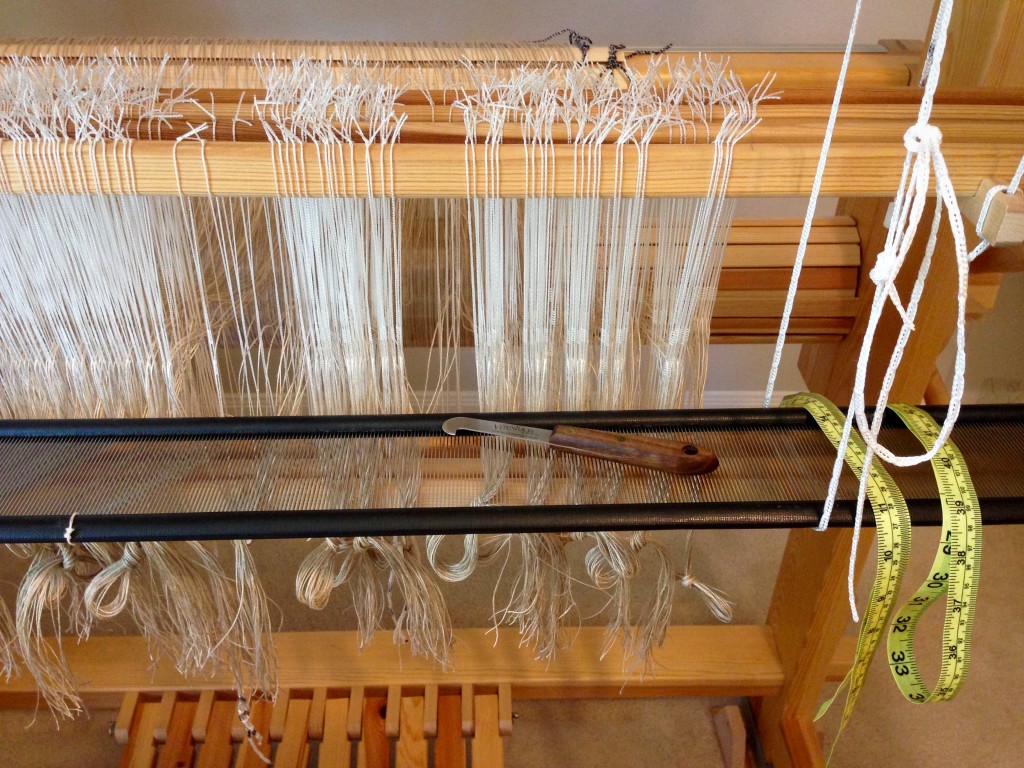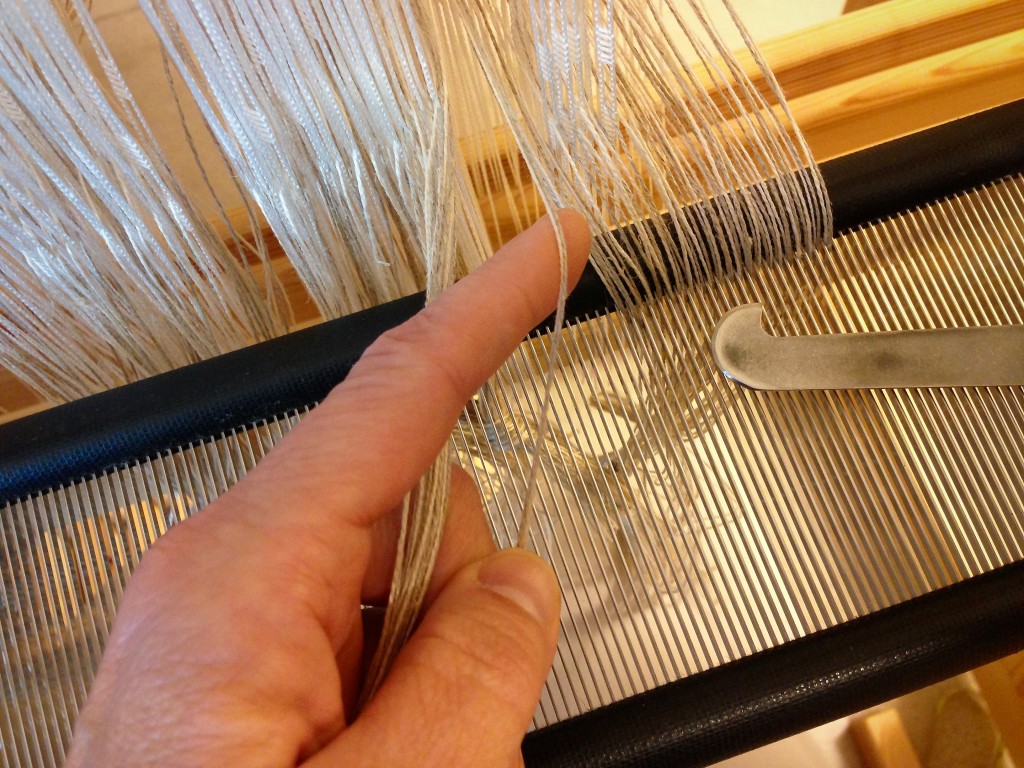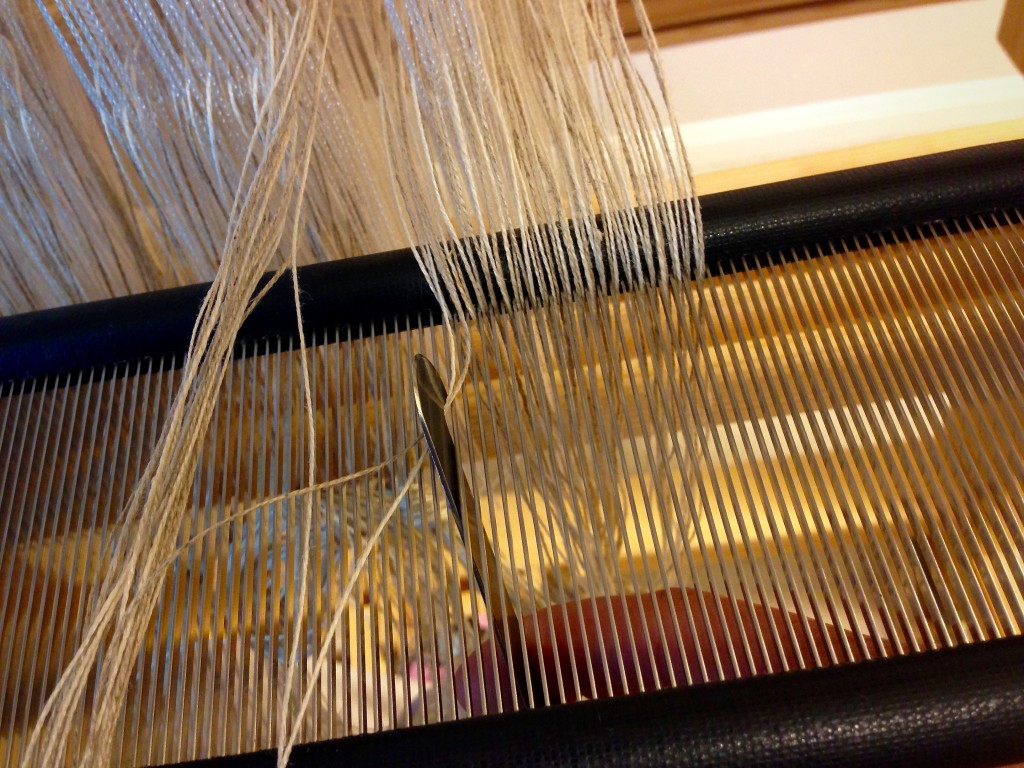I am dressing the big loom with linen. This flaxen thread brings a worthwhile challenge I find hard to resist. Beaming the warp was slow and deliberate. It pays to be attentive to everything at this stage. Threading for this dice weave could not be simpler; it was finished before I knew it. Now, it is time to sley the reed.
Tools:
- Reed I am using a 12-dent reed for this project.
- Texsolv cord for hanging the reed in front of the shafts
- Tape measure I remove the metal ends.
- Reed hook Mine is from Vävstuga.
- Bench, set at comfortable height for threading and sleying With my Glimåkra Standard, I get to put the bench “in” the loom. It’s like going into my own little playhouse.
- Good lighting I use a small Ott Lite Task Lamp when natural light in the room is dim.



- Form two loops of Texsolv cord that hang down from the top of the loom, one on the right and one on the left, to hold the reed for sleying. My Texsolv loops hang from the countermarch frame.
- Adjust the length of the Texsolv loops so that the reed will fall just below the eyes of the heddles.
- Rest the reed horizontally in the Texsolv holders.
- Use the tape measure to find the center of the reed. I mark the center of my reeds permanently by tying a small piece of 12/6 cotton seine twine at the center.
- Find your weaving width measurement on the tape measure. Fold that measurement in half and place the folded tape measure at the center point on the reed, to the right, to find the starting dent for sleying the reed. Place one end of the tape measure in that starting-point dent to keep your place. Some people use the reed hook as a place holder, but when I pick up the reed hook to sley the first dent, I invariably loose my place.
- Pull ends through the reed with the reed hook, referring to your draft for the correct number of ends per dent, starting at the dent on the right hand side that has the place holder in it. Good lighting helps to prevent errors. This is especially true with finer dents and darker threads.
- After sleying each group of warp ends, visually examine the sleyed dents to look for missed dents or extra ends in dents.
- Tie the sleyed group of ends into a slip knot.
- Finish sleying all the ends; and smile, knowing you are a step closer to weaving fabric.
May all your looms be dressed.
Happy Dressing,
Karen

wow so different from front to back. slaying is done before threading. The reed is used to line everything up…reed to heddles… to backbeam.
Linen on linen is notorious for wonkey edges. Now is a great time to use that spreader. Have fun and good luck. can’t wait to see the finished project.,linda
You have me figured out. I certainly will use a spreader!
Karen
I’m so happy your using some linen, I’m looking forward to see what you make!
Liberty, I’m excited, too. This is going to be fun.
Karen
Oh joy! I read your reference to going into your own little playhouse and my heart danced. I feel exactly the same way every time I slip inside the loom. Thanks for your continued inspiration and witness.
Deb,
Your comment makes me smile. I feel like we have a special bond – playhouse dreamers. Another reader wrote to me and expressed the same delight about hiding away inside the loom. I’m glad I found words that made your heart dance!
Happy Weaving,
Karen
Hi Karen; you are so prolific!! Can you tell me the pattern for dice weave; I have looked and looked for that name. Maybe monk’s belt? No long floats on the back like overshot, I hope?? I thought it could make a nice scarf. Happy weaving down there. Fran
Hi Fran,
I discovered dice weave in “The Big Book of Weaving” by Laila Lundell, and I haven’t found it in any of my other Swedish weaving books. Maybe it is known by another name that I am not aware of. It is very similar to monk’s belt. Perhaps it is considered a simplified version of monk’s belt because it only uses three treadles. I really like the simple clean look of this two-block weave.
It does have floats on the back, corresponding to the floats on the top. The pattern weft floats over the top and under the back, so you could make shorter floats by making the blocks smaller.
I think it would make a very interesting scarf!
Happy Weaving,
Miss Weave-a-lot